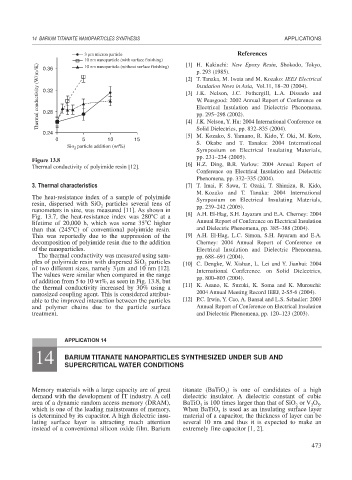Page 501 - Book Hosokawa Nanoparticle Technology Handbook
P. 501
14 BARIUM TITANATE NANOPARTICLES SYNTHESIS APPLICATIONS
3 m micron particle References
10 nm nanoparticle (with surface finishing) [1] H. Kakiuchi: New Epoxy Resin, Shokodo, Tokyo,
Thermal conductivity (W/m/K) 0.32 [2] T. Tanaka, M. Iwata and M. Kozako: IEEJ Electrical
10 nm nanoparticle (without surface finishing)
0.36
p. 293 (1985).
Insulation News in Asia, Vol.11, 18–20 (2004).
[3] J.K. Nelson, J.C. Fothergill, L.A. Dissado and
W. Peasgood: 2002 Annual Report of Conference on
Electrical Insulation and Dielectric Phenomena,
0.28
pp. 295–298 (2002).
Solid Dielectrics, pp. 832–835 (2004).
0.24 [4] J.K. Nelson, Y. Hu: 2004 International Conference on
[5] M. Kozako, S. Yamano, R. Kido, Y. Oki, M. Koto,
0 5 10 15
S. Okabe and T. Tanaka: 2004 International
Sio particle addition (wt%)
2
Symposium on Electrical Insulating Materials,
pp. 231–234 (2005).
Figure 13.8
Thermal conductivity of polyimide resin [12]. [6] H.Z. Ding, B.R. Varlow: 2004 Annual Report of
Conference on Electrical Insulation and Dielectric
Phenomena, pp. 332–335 (2004).
3. Thermal characteristics [7] T. Imai, F. Sawa, T. Ozaki, T. Shimizu, R. Kido,
M. Kozako and T. Tanaka: 2004 International
The heat-resistance index of a sample of polyimide Symposium on Electrical Insulating Materials,
resin, dispersed with SiO particles several tens of pp. 239–242 (2005).
2
nanometers in size, was measured [11]. As shown in
Fig. 13.7, the heat-resistance index was 280 C at a [8] A.H. El-Hag, S.H. Jayaram and E.A. Cherney: 2004
lifetime of 20,000 h, which was some 35 C higher Annual Report of Conference on Electrical Insulation
than that (245 C) of conventional polyimide resin. and Dielectric Phenomena, pp. 385–388 (2004).
This was reportedly due to the suppression of the [9] A.H. El-Hag, L.C. Simon, S.H. Jayaram and E.A.
decomposition of polyimide resin due to the addition Cherney: 2004 Annual Report of Conference on
of the nanoparticles. Electrical Insulation and Dielectric Phenomena,
The thermal conductivity was measured using sam- pp. 688–691 (2004).
ples of polyimide resin with dispersed SiO particles [10] C. Dengke, W. Xishan, L. Lei and Y. Jianhui: 2004
2
of two different sizes, namely 3 m and 10 nm [12]. International Conference. on Solid Dielectrics,
The values were similar when compared in the range pp. 800–803 (2004).
of addition from 5 to 10 wt%, as seen in Fig. 13.8, but
the thermal conductivity increased by 30% using a [11] K. Asano, K. Suzuki, K. Soma and K. Murouchi:
nanosized coupling agent. This is considered attribut- 2004 Annual Meeting Record IEEJ, 2-S5-6 (2004).
able to the improved interaction between the particles [12] P.C. Irwin, Y. Cao, A. Bansal and L.S. Schadler: 2003
and polymer chains due to the particle surface Annual Report of Conference on Electrical Insulation
treatment. and Dielectric Phenomena, pp. 120–123 (2003).
APPLICATION 14
14 BARIUM TITANATE NANOPARTICLES SYNTHESIZED UNDER SUB AND
SUPERCRITICAL WATER CONDITIONS
Memory materials with a large capacity are of great titanate (BaTiO ) is one of candidates of a high
3
demand with the development of IT industry. A cell dielectric insulator. A dielectric constant of cubic
area of a dynamic random access memory (DRAM), BaTiO is 100 times larger than that of SiO or V O .
3
5
2
2
which is one of the leading mainstreams of memory, When BaTiO is used as an insulating surface layer
3
is determined by its capacitor. A high dielectric insu- material of a capacitor, the thickness of layer can be
lating surface layer is attracting much attention several 10 nm and thus it is expected to make an
instead of a conventional silicon oxide film. Barium extremely fine capacitor [1, 2].
473

